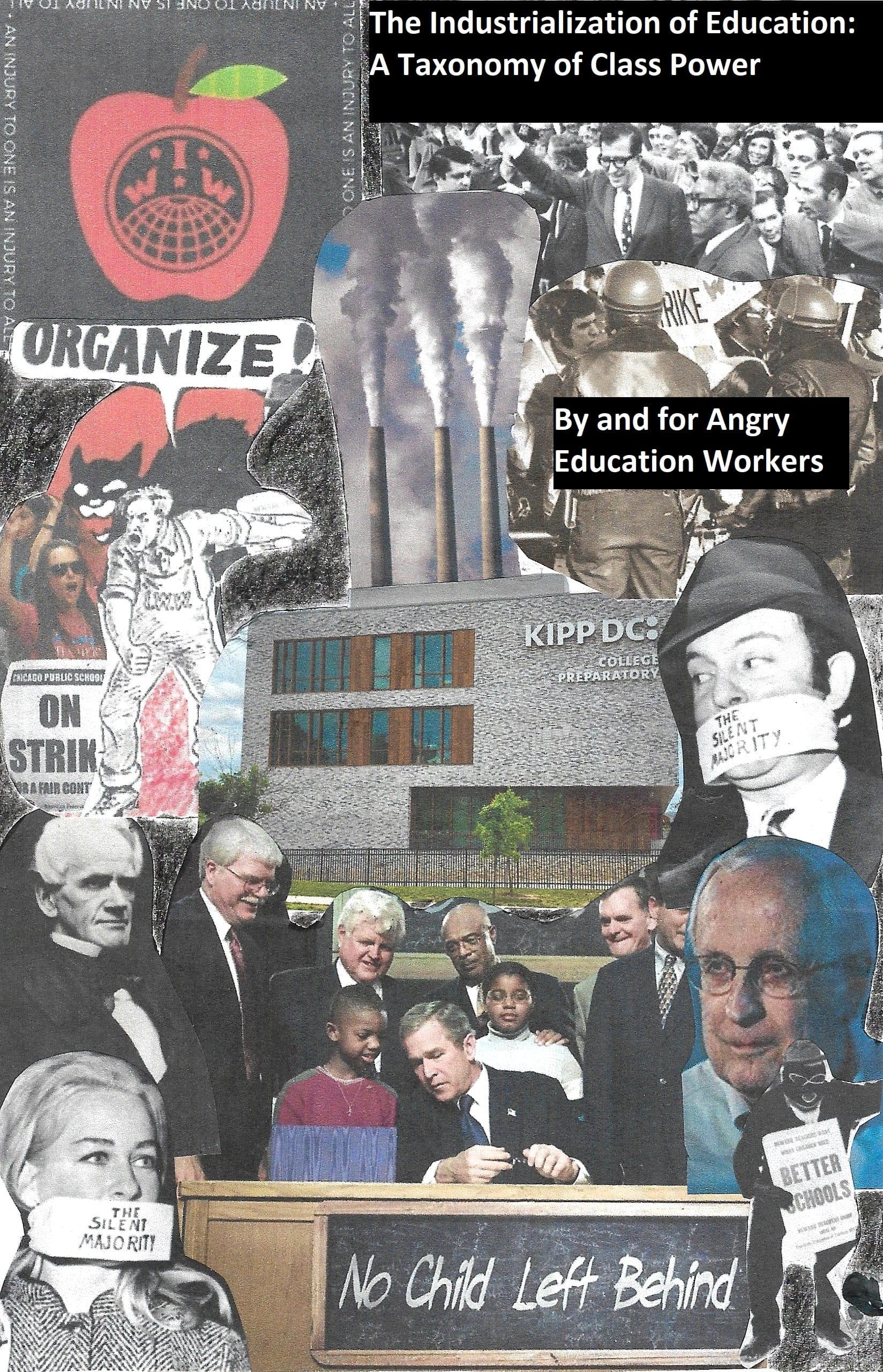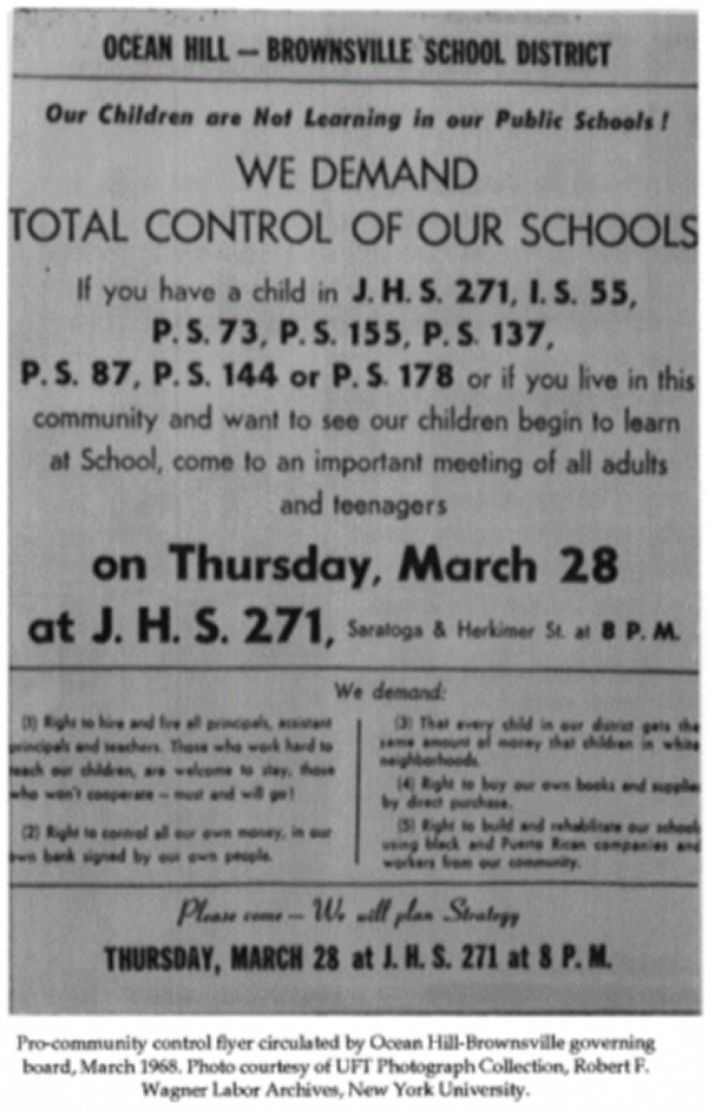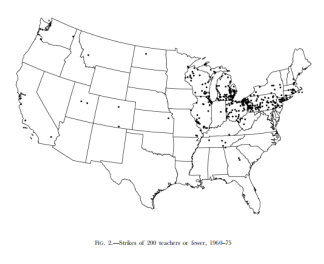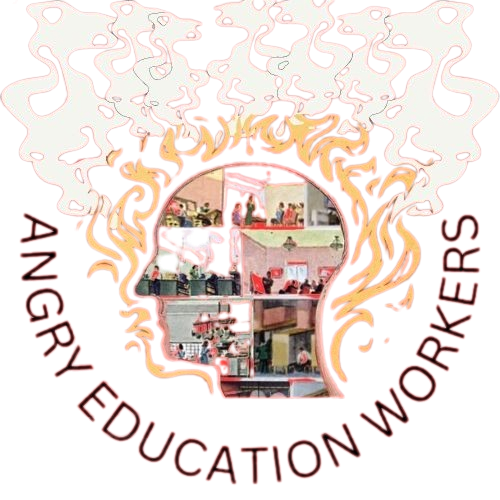The Industrialization of Education: Phase Two, 1954-1975

This three-part study of the education industry is by and for Angry Education Workers, a political art collective open to all instructional and support staff in schools, museums, libraries, and archives.
The Industrialization of Education - printable booklet version
Realignment and Recovery
When the Great Depression slammed the brakes on the world economy in 1929, it halted decades of industrialization in the schools of the American Empire. From 1890 to 1930, the education systems of the country had expanded rapidly. Student enrollment, workforce size, the number of facilities, and investment from public and private sources all grew. Economic catastrophe brought this to a halt.
Funding, workforce size, and building construction stagnated or shrank (Koning 2015) (NCES 2008). School systems struggled to stay afloat. World War II revived the economy, but only so the government could direct every spare resource towards the war, leaving little left over. Enrollments leveled off at around 25 million. The attendance percentages of school age children peaked at around 84 percent, while the teaching workforce stalled at 900,000.
By 1950, the sun had come out, the flood waters had receded, and the conditions for unprecedented growth in education were just right. Especially as the government itself restructured and expanded along the lines of industry.
The Industrialization of the State
Social strife at home in the 1930s and global warfare abroad transformed the American Empire’s national state apparatus into an industrial enterprise. Prior to 1930-1945, the American nation-state had a narrow role in shaping state and local policy (Scribner 2015). Especially in education, where the federal government delegated almost all responsibilities to state and local governments (Scribner 2015).
Gilded Age Industrialist robber barons used the federal government for its “police power,” rather than for a source of money for reinvestment and transformation into profit (Gross 2018). State power was a wedge to pry open opportunities for profit from the education system. All that changed by the end of the 1950s with the industrialization of the state—the public sector—itself.
The New Deal and World War II required the American Empire’s federal government to mobilize unprecedented amounts of resources. Until 1930, the federal government usually spent around three percent of the Gross Domestic Product (GDP). This trend held true in all the history from 1797 to 1930, with three exceptions.
All for wars, of course. During regular times, most of that three percent went to the military, or interest payments on debt. The New Deal and WWII “expanded the role of the state dramatically” (Shelton 2017, 3). Government spending has consistently increased ever since then (Barro 2012).
One angle of background accumulation was the gradual buildup of the state’s police power, regulatory infrastructure, and competence with managing its human capital stock. At the end of World War II, the American Empire had the most powerful state in the world, one that could intervene in the social fabric of its host society on a genetic level.
The “massive expansion of state services dramatically increased the number of public employees” (Shelton 2017, 4). They produced the goods and services offered by the state to the population at large. The boss was the state itself. Taxpayers/voters became a sort of hive-mind public boss that could exercise power at the ballot box and the mob. Funding and personnel for police and other internal security forces, like the FBI, “grew precipitously after 1965 and then never dipped, sucking up ever-larger slices of municipal budgets” (Soss & Weaver 2017, 570).

The Industrialization of Education in the Post-War Era
As the dust and rubble of the war was cleared away, “education had become even more fundamental for Americans in procuring opportunity as the U.S. economy transitioned toward more highly skilled, white-collar employment” (Shelton 2017, 14). Meeting the demands of their own war machine for labor power required an industrialized public sector to produce the workforce. By 1960, there were over two million teachers in the empire to help meet this demand (Shelton 2017).
Rising student enrollment required ramping up production methods. Census data from the time shows a consistent and rapid rise in school attendance figures across all ages. The percentage of children who completed high school shot up from 67% in 1947 to around 90% by 1975, where it plateaued. In higher education, the magnitude of the changes was even greater. The percentage of Americans eighteen- and nineteen-years old seeking education services tripled (US Census Bureau). These trends continue through the early twenties age range.
These enrollment levels brought billions in direct investments employers didn’t have to pay for. By 1976, state governments in America now poured $70 billion into the education industry every year—compared with less than six billion dollars in 1950. Through political connections, capitalists could manipulate this firehose of funding to be spent in ways that would best line their pockets.
Education thus became further commodified in the post-war period to meet the needs of the military-industrial complex as they pursued their Cold War crusade. Those who resisted had the prison and the graveyard awaiting them.
Race, Segregation, and the Education Industry
Black Americans fled racist violence and poverty in the South and migrated to major city centers in the North during the Great Migration. They found no promised land. “Realtors, banks, and white residents combined” to consign Black Americans to ghettos and underfunded, overcrowded, chaotic school systems almost impossible to escape (Lyons 2008, 134). There, their children were “refined” on an assembly line into their roles in capitalist society. Black American enrollment “climbed from 74,000 in 1950 to 250,000 in 1963, or from 21 percent to 47 percent of the total” students in Chicago schools, for example (Lyons 2008, 136). White workers—occupying a privileged position as enforcers of a white supremacist order—would “refine” these children.
White teachers had a complicated relationship with the Black and Puerto Rican communities they taught. On paper, teachers' unions had been staunch allies of the Civil Rights Movement for decades. Two years before Brown v. Board of Education, the membership of the AFT voted to expel any local that refused to racially integrate its membership (Easterling 2013). On the other hand, teachers had incendiary conflicts with Black communities in cities around the Northeast and Midwest from 1968-1973 (Shelton 2017).

Such conflagrations took place during the Strike Wave Era. It was a wider period of class struggle within public education spanning 1960 to 1981. Teachers achieved some dignity and professionalism at their jobs through militant, illegal strikes (Shelton 2017). “Other public sector unions expanded in the 1960s, but none saw as much militancy as teachers’ unions”. An article in Times from 1963 compared teachers’ militant strike actions to those of dockworkers. AFT membership rose from 59,000 to 205,000 from 1960-1970, underscoring how militant struggle can convince workers to join. Even the NEA, after launching strikes, saw membership rise by 700,000 between 1960-1970 (Lyons 2008).
From 1960-1968, teachers solidified collective bargaining agreements that often more than doubled their salaries (Shelton 2017). They also ended many of the indignities they’d collectively endured for decades. Previously, principals could force teachers to stay long after the working day had ended, assign random duties at will, and withhold paychecks. They now had their authority circumscribed.
By and large, the public supported them, too. Hundreds of thousands of teachers, out of 900,000 total, participated in strikes or other work stoppages throughout the decade (Covington 1971). Teachers’ unions built such awesome power that they became “junior partners” of school boards in administering many urban school systems by 1970 (Shelton 2017). This put them in a compromising position.
Many white educators were (and are) racist. Black activist parents felt that white teachers and white controlled school systems did not care about, or hated, their children. Between 1968 and 1973 some striking teachers’ demands included reinstating corporal punishment for “unruly” students—usually poor Black children (Shelton 2017). That alone was enough to alienate many Black parents and Black educators. Trade unionism, infected with racism and an organizing model fragmented by job role and skill, inflamed the problem.
For some, the solution was community control of neighborhood schools. There were attempts to implement this. Most were funded and supported by philanthropic foundations of the rich. The way they eroded teachers' due process rights and working conditions enraged unionists (Goldstein 2014). Bitter and often violent strike actions by teachers followed. Fighting each other weakened both communities, exposing them to the predations of the rich (Shelton 2017). Cities with already majority Black teacher workforces and populations, like Washington DC, avoided these conflicts in the first place (Easterling 2013). Some union locals reformed in response, such as the CTU, and regained much more support from Black communities even by the early 1970s (Lyons 2008).
But on the whole, white teachers were unwilling to compromise with Black community members. They wanted mostly women education workers to resume “additional (unpaid) care labor” (Shelton 2017, 70). Teachers’ recent memories of these assignments from before the beginning of the Strike Wave Era “loomed large in many teachers’ decision to join the union” while many “teachers remembered class sizes of up to forty” in Newark, New Jersey (Shelton 2017, 67).

Ultimately, in most of these strikes, it was the unwillingness of the school boards and mayors to negotiate that set the stage for conflict between Black parents and white teachers (Goldstein 2014) (Shelton 2017). These are tried and true union busting tactics. “Almost half of the city’s teaching force crossed the picket lines, as many of the city’s black teachers allied” with the Black public of the city (Shelton 2017, 71). Black Power activists worked with Amiri Baraka to break picket lines, while white teachers allied with local racist vigilante: Tony Imperiale.
It’s hard to see these white teachers allying with someone who sought “help from supporters of George Wallace” (Shelton 2017, 71) for the sake of members’ personal economic interests as anything except collaboration with middle class fascist formations. White teachers betrayed the Black freedom struggle. They used white hostility to integration for their own benefit. This came around to bite them in the ass. Teachers secured higher salaries and a near-professional status, but lost community support. It is especially ironic, because many of the woes teachers experienced during the unsolved urban fiscal crises of the 1970s were a direct result of white flight to the suburbs (Shelton 2017). These white suburbanites denounced teachers and turned American politics towards market reforms (Shelton 2017).
Despite the privations of 1970s stagflation, white Americans had accessed the benefits of a strong, stable economy fueled by militarist largesse, imperialist violence. A well-regulated labor market had offered them access to educational and economic opportunities for over 25 years. Since teachers are workers, they had access to the prosperous mainstream economy. Meanwhile, white capitalists permanently shut millions of Black Americans out of a labor market synonymous with a life of basic safety and economic security (Desilver 2013) (Shelton 2017). They had been cut out of most New Deal program benefits from the beginning.
Young Black people, experiencing constant racism and discrimination in school, often dropped out (Goldstein 2014). That left working low-wage jobs or joining spreading street gangs. Initial/background accumulation is an ongoing process. Further dispossession of colonized people is a necessary byproduct of an industrializing education system.
White workers were complicit. Teachers and their unions were no exception. The Chicago Teachers Union (CTU) closed ranks with Mayor Daley to receive better salaries and benefits, allowing him to outflank the city’s Civil Rights and Black Power movements (Lyons 2008). In the South, a cohort of white teachers taught in private (but publicly funded) segregation academies as integration orders began (Black 2020) (Rooks 2017). This is part of a historical tendency in the history of America where poor, working/middle class, affluent, and rich whites unite in the face of challenges from colonized peoples. This is the essence of fascism.

Raucous fights between teachers and urban school boards were commonplace and dominated the news and the political conversations everyday people were having (Shelton 2017). These strikes caused wide swathes of Americans—from urban Black people to unionized white workers in the suburbs to elite liberal technocrats—to lose faith in the New Deal Coalition management of cities and workforces (Shelton 2017). People began to rethink previous political assumptions. In this chaos and confusion, the corporate sector succeeded in pushing deregulation and privatization in education.
Petty Tyrants: The Public Boss Class
First, big business interests and politicians needed local allies to be their boots on the ground against organized labor. They tapped into geographically disparate, but culturally homogenous groups of Americans with historical privilege and power in primarily rural and suburban areas. We will refer to them as the public boss class: the voting “public,” usually (white) landowning farmers, small industrialists, and suburban homeowners, the middle class “taxpayers” (Scribner 2015) (Shelton 2017). Nixon called them the Silent Majority.
Vigilantism has always played a major role in American ‘justice.’ White mob violence against Black Americans, indigenous peoples, immigrants, and workers of all backgrounds features prominently in the history of this nation. Frequently, these mobs have targeted teachers suspected of being communist. There was a specter haunting the teaching workforce, of course. During the 1920s and 1930s, there was a strong current of radicalism among many teachers. Locals in Detroit, New York, Philadelphia, and Newark voted communists into leadership (Taylor 2013). These communist locals exemplified and sharpened the best instincts of teachers’ unions through their connections to social movements (Toloudis 2019) (Taylor 2013).
Even though most teachers in these locals were not communists, they continually voted them into leadership for their reputations as strong, principled union militants (Taylor 2013). The AFL even had to strong-arm the AFT to expel communist locals in 1941 to prevent them from spreading (Taylor 2013). Class collaborationist union leaders across the labor movement did the same (Taylor 2013). Anti-communism and Cold War imperialist games motivated the creation of an education industry that was truly national in scale.
The Industrialization of Rural Education
Congress responded to the USSR’s launch of Sputnik with the National Defense Education Act in 1957 (Goldstein 2014). Several hundred million dollars was set aside for training the top achieving students for careers in science, math, and technology. The logic of national security enticed executives of defense companies and politicians to invest heavily in education to ensure supremacy over the USSR. A mass of federal funds flowed into the education industry for the first time.
Lyndon B. Johnson’s Elementary and Secondary Education Act (ESEA) of 1965 then further centralized the education industry on a national scale. It provided a large, consistent stream of federal funds for local and state public school systems (Goldstein 2014). Access to this money comes with conditions that vary depending on who holds power. The federal government married the police power to the power of the purse.
This fundamentally transformed education policy and created a truly national education industry. Education’s trajectory paralleled the late 19th Century emergence of a national American marketplace and regulatory framework with the Second Industrial Revolution. Federal policy summoned a state infrastructure capable of intervention in education across the entire empire. His government helped push industrialization outside the city school districts, past the suburban towns, and deep into the countryside. Rural, white landowners and small business owners interacted with these changing school systems.
Outside urban centers, industrialization never took hold in schools and libraries. Into the 1970s, there were still 1,200 one-school districts in rural areas. Up through the 1950s these one-room schoolhouses were the main providers of education in the countryside (Scribner 2015). They operated under direct local governmental authority, a tradition of “voter control” that residents fiercely protected against “urban-type schools” (Scribner 2015, 537). There were few centralized education production facilities in the countryside from the Northeast to California. Each school only had one teacher, and “through the early 1900s teaching remained a part-time job suited to transients or young women biding their time until marriage” (Scribner 2015, 536).
Libraries in the West and rural South rarely had more than one librarian each. Any other workers were community volunteers. Collections were usually outdated, and library workers had to update them with few resources (Hillary and Abbot 2015). Funding came almost entirely from local property taxes, keeping education production highly localized in scale. Tax paying landowners were notoriously stingy (Scribner 2015).
Oversight of education at the state level grew starting in the 1910s. “Coalitions of education associations, corporate foundations, and social welfare reformers” lobbied “legislatures to increase thresholds for school funding and teacher preparation” (Scribner 2015, 533). One-room schoolhouses began to close and consolidate. The resistance of rural communities slowed this process.
After World War II state legislatures and courts raised curriculum requirements and qualifications. They tied state-level funding to consolidation in some way. Wisconsin passed a law in 1959 “essentially outlawing the one-room schoolhouse” by requiring that all districts operate a high school to access state money (Scribner 2015, 537) (Goldstein 2014). From 200,000 one-school districts in 1915, 1,200 existed by the 1970s. The number of school districts in Wisconsin collapsed from over 5,000 to less than 600 (Scribner 2015). Local tax revenues covered over 65 percent of American education spending in 1945. That dropped to less than 50 percent by 1975 (Scribner 2015). Capital was now circulating across a much wider geographic space.
School consolidation, the following rise in property taxes and number of unionizing teachers activated the public boss class. They viewed themselves as the only productive members of society (Shelton 2017). Their dispersed communities allied when “residents tapped into the stream of antiunion literature propagated by conservative business interests like the John Birch Society” (Scribner 2015, 538). Teachers were cast as outsiders and special interest groups (Schirmer 2016). Taxpayers maligned unions as anti-democratic bodies that reduced voter control of schools. Rebellious union teachers had to be “cowed” to stay in line at the ballot box and—more ominously—through vigilantism. The 1974 Hortonville teacher strike—when “taxpayers” enlisted unemployed young men to violently target strikers—is one of many examples.

Most in the public boss class do not have school-age children. Or redirect their children to private, parochial, or suburban public schools to avoid racial or class integration. These were conscious choices. Thousands of letters to newspapers throughout the 1970s threatened to join their counterparts streaming to the suburbs as a direct response to teachers’ strikes, which had raised property taxes (Shelton 2017). The public boss class “opened up a space in which commentators began to imagine alternatives to the public school system” (Shelton 2017, 185) (Costello 2006).
The newspaper industry played a central role in mobilizing the public boss class. Newspapers, fighting their own battles with unionizing workers, maligned striking teachers (Shelton 2017). They published endless op-eds denouncing teachers and letters smearing urban teachers. They galvanized the public boss class with its coverage of Prop 13 in California, which amended the state constitution to permanently cap property taxes. Their virulence sharpened after 1973 when teachers launched strikes from St. Louis to Philadelphia to New York, demanding more control over curriculum and other higher level school decisions (Shelton 2017).

Conclusions
Centralized production facilities and workforces in education now existed across the empire, along with an ossifying hierarchical management structure. Of course, there is incredible diversity across district, state, and regional boundaries, with most rural school workforces still encompassing only 50-200 workers (Scribner 2015). This makes sense. Until recently, small businesses were the largest portion of the country’s economy. Most workshops during the Second Industrial Revolution had less than twenty workers (Duncan 2018) (Cameron & Neal 2003) (Vicente 2010). Division of labor is more important for capitalist production than workforce size by itself.
Accumulation of starting capital had largely already taken place, as well. After plundering half of North America and vast swathes of West and Central Africa to build its industrial infrastructure, the American Empire was ready to go global. As a superpower, it effectively controlled much of the world outside the Communist Bloc. Drawing in wealth from Central America, South America, Southwest Asia, Southeast Asia, and parts of Africa, the government and corporations had nearly unimaginable resources to redistribute through its industrialized public sector.
The story of rural school consolidation and the rise of the public boss class demonstrates how a national education industry and marketplace emerged. Imperialist competition with the Soviet Union conditioned this process as the Cold War poisoned all American life. At every stage in the life cycle of the education industry in the Post-War and Neoliberal Eras, this Silent Majority—which is neither silent nor a majority—was present to beat education workers into line. Sometimes metaphorically, sometimes literally. Their collaboration with the rich white capitalist class opened the way for the Neoliberal Era’s privatization and re-segregation of the education industry. Profits have grown to incredible levels thanks to them.
The money is pouring in, but the capitalists are yet only indirectly profiting from education. For industrialization to reach its zenith, it has to be possible to extract that capital—plus value added by the labor of education workers. In 1992, this came to pass.

See our References page for our sources.
Stay tuned for Phase Three!
Thanks for reading! Get in touch! angryeducationworkers@gmail.com
Thanks for reading Angry Education Workers! Subscribe for free to receive new posts and support our work.
1 The War of 1812, The American Civil War, and World War I
2 Many Black activists felt that the Civil Rights Movement had failed to achieve integration and turned to a more radical set of programs looking to build Black power separate from white society.
3 Poet and musician formerly and sometimes still mistakenly referred to as LeRoi Jones. He became heavily involved in Black Nationalist, and then Marxist Leninist, radical organizing after Malcolm X’s assassination. https://poets.org/poet/amiri-baraka
4 He would eventually become a local politician and go on to try and suppress the Black vote for the Republican party. https://www.nytimes.com/1999/12/28/nyregion/anthony-imperiale-68-dies-polarizing-force-in-newark.html
5 High inflation, high unemployment, low growth. https://www.investopedia.com/terms/s/stagflation.asp

